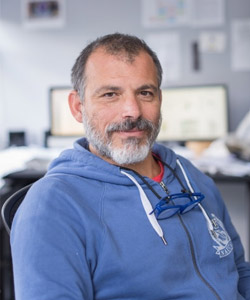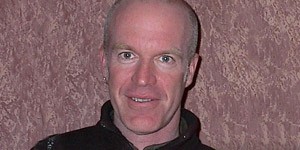By Guillermo Moreno-Sanz

Dr. Moreno-Sanz has authored more than 30 scientific articles and 3 patents describing the role of the endocannabinoid system in pain perception. Graduated in Biochemistry and Organic Chemistry from the University of Zaragoza, he obtained his PhD in Neuroscience from the Complutense University of Madrid, in Spain. He gained extensive international experience with long-term fellowships in the Netherlands, Italy, and the United States, developing most of his academic career at the University of California, Irvine, where he discovered a new class of cannabinoid analgesic with high clinical potential. In 2017, he acted as a consultant to the National Academies of Sciences of the United States in the preparation of the report "The health effects of cannabis and cannabinoids" and later founded Abagune Research to offer scientific advice and R&D solutions to the international cannabis industry. In 2020 he assumes the scientific and medical direction of Khiron Life Sciences in Europe.
Meet the Experts is a series of interviews conducted by experts from the field of Cannabis to world leaders in research and clinical practice of Cannabis as medicine.

Giovanni Marsicano is a neuroscientist with a large experience in the study of the roles of CB1 receptors and the endocannabinoid system (ECS). Veterinary Doctor of education, Giovanni currently holds the positions of Group Leader and Deputy Director at the NeuroCentre Magendie (Inserm, Bordeaux), where he coordinates animal studies aimed at understanding the roles of the CB1 in the control of aversive memories, food intake, excitatory/inhibitory balance, olfactory and memory process, the processing of higher order cognitive function, the interactions between astrocytes and neurons, and on brain mitochondrial activity and its impact on behavior.
Guillermo Moreno-Sanz: How did you first got involved with cannabinoid research?
Giovanni Marsicano: I am a Veterinary Doctor, but I realized very soon that the lab was a much more appealing place for me than the veterinarian practice or the stall. So, after my degree in 1992, I first worked on farm animal stem cells in a lab in Cremona, which is known for Stradivari's lutherie and pig farms. We did not have Internet and the closest scientific library was at 30 Km, but I learnt a lot about cell biology techniques, while participating in a European project that would lead eventually to the cloning of the sheep "Dolly" by Ian Wilmut in Scotland. Then I spent two years in a private pharma company in Siena (called at that time Biocine), working on xenotransplantation, by genetically modifying animal organs to transplant into humans. Siena is a fantastic town and I had really good time there, but the research subject was not heartwarming for me. So, I found myself again in the middle of a crossroad: I had either to change my job (maybe go back to being a vet) or to find an appealing research subject. So, I started looking in Nature ads all around the world and found a young PI from Max-Planck of Psychiatry in Munich, Beat Lutz, who was looking for PhD students to work on "Genetics of Behavior". I thought: "This sounds interesting". I applied and met Beat in springtime 1997. His intention was to use conditional mutagenesis to better dissect the brain circuits involved in learning and memory. I loved the idea and he offered me the position. Just before leaving his office, he added: "By the way, I work mainly on transcription factors, but if you think of any gene that might be interesting to delete, we can discuss it". At that time, as a veterinarian with some research experience in immunology and cell biology, I had no idea about neurosciences, and I was going to start in November. I spent the summer of 1997 reading like never in my life. Books, articles, reports of meetings... everything. It was the early days of behavioral mutagenesis. The first knock-out models to study learning and memory that had been generated were all "loss-of-function" approaches: You delete a gene (Cam Kinase, NMDA receptor subunits, etc.), the mouse is impaired in memory tasks and hippocampal synaptic plasticity, and bang! seminal papers in Nature, Science, Cell... However, there was also this emerging notion that there where physiological systems to "limit" memory. For instance, the dominant hypothesis at the time was that phosphorylation was important to promote memory and, therefore, phosphatases (the enzymes removing phosphate groups from proteins) were logical candidates to regulate memory processes. So, I started thinking of phosphatases and reading about them: a fascinating field of very subtle actions and counteractions to maintain fragile balances. One day, however, my future wife, Astrid Cannich (who, by the way, was living in Munich) sent me an article that all cannabinoid freaks (should) know well: the 1997 Nature paper by Nephi Stella, Paul Schweitzer and Daniele Piomelli, showing how 2-AG negatively modulates hippocampal synaptic plasticity. I then started checking the cannabinoid literature and I found that, indeed, activation of cannabinoid receptors was generally linked to impairment of memory.
GMS: Was that the aspect of endocannabinoid physiology that interested you more at that time?
GM: So, at that point, I had two "negative" modulators of memory, two potential candidates to propose to Beat. The choice was difficult. Cannabinoid receptors were very cool for the reasons we all know, but phosphatases were also very interesting candidates. So, I used a very scientific method to choose. The car plates in Munich start with "M", generally followed by two letters. I told myself: "If within a week, I see a M-KP car plate (Map Kinase Phosphatase), I stick to the phosphorus stuff. Otherwise, I propose CB1 to Beat". Obviously, I did not see any M-KP plates and Beat was crazy and intelligent enough to accept the idea. We started from scratch. At that time there were no companies making KO mice and no genomic sequence data either. We had to map the CB1 gene locus by solving sorts of jigsaw games made by gel patterns resulting from enzymatic digestions of DNA. It took two and a half years, basically all my PhD, to obtain those mice. In the meantime, I was reading and dreaming of what we could do with them. After more than 20 years, I have to say that those were not bad dreams...and I will never stop thanking Beat for his courage to start a completely new pathway with me.
GMS: Your career has been somewhat atypical. Would you have done things differently in retrospective?
GM: No, I would not change anything. Even the years before finding my "true passion" were useful and taught me a lot. I am deeply convinced that young people should not spend too much time on "planning" their future, but mostly in trying to understand what they really like. It is not banal and it can take long time. In the while, ears, eyes and all senses have to stay wide open to catch any type of interesting stimulus. Then, life is full of opportunities that you would have never expected the minute before. But if your senses are not ready, you may miss them. Luck is an important element, but if you are open to receive the lesson, even bad luck will teach you something.
GMS: You are one of the most prolific researchers in the cannabinoid field, not only for the extension and quality of your research but, also, for the many different topics and molecular tools you have employed and developed.
GM: Modern Western science has its "good" and "bad" in one word: specialization. It is good, because by specializing we can dissect the minimal elements that determine the work of life, allowing us not only to understand the detailed mechanisms of the body, but also to "fix" them when they do not work properly. At the same time, particularly when dealing with a complex phenomenon like behavior, specialization carries the intrinsic risk to lose the "whole picture", to see how any specific element that we are studying is connected with others in an infinite chain of extremely complex systems. Studying the CB1 receptor allows us to be extremely specialized, because we work on one protein and few other elements surrounding it. At the same time, however, endocannabinoid signaling is involved in almost anything what happens in the body. Therefore, staying specialized, CB1 obliges us to keep an eye on the larger picture, which is what I love in science: We should never forget that the scientific approach goes into the "small", but its final aim is to understand the "big". That's how we came across different fields. Through unexpected paths, CB1 led us to mingle into fields that I would have never considered before.
GMS: Which of your scientific contributions are you most proud of?
GM: It is always difficult and a bit stupid to praise oneself. I am of course proud of discoveries, but most importantly I am proud of the people working with me, of their enthusiasm and of their commitment to trying to understand the brain with an open mind, positive attitudes and while having fun. I counted now about 70 Masters/PhDs/post-docs who passed through my lab in the last 14 years (since I arrived in Bordeaux). I am proud of each of them, and I am thankful to them for helping me spending these years in the best possible way.
GMS: The first of your articles I ever read was the 2002 Nature describing how endocannabinoids control the extinction of aversive memories. How do you remember that time?
GM: Surely that paper is the keystone of my scientific career. I must thank Carsten Wotjak, who had just started his lab at the Max-Planck Institute of Psychiatry in Munich. We asked for his help to figure out what an interesting behavioral phenotype for the CB1-KO mice could be, because he is an expert in fear memory studies. I remember when he showed us the fear conditioning results in Beat's office. As you might know, freezing behavior is used in those experiments to "measure" the association of a conditioned stimulus (eg a tone) and an unconditioned one (eg a foot shock). To put it simple, the more freezing the exposition to a tone elicits, the more we can extrapolate that the mouse "remembers" the previous association between the tone and the foot shock he received previously. Carsten showed the data of first exposition to tone: no difference between wild-type and mutant littermates. "Well," I thought, "maybe deleting CB1 was not such a great idea..." But Carsten, with his typical luciferin smile, removed a piece of paper covering the data related to the following exposures to the tone. Whereas wild-type mice normally and progressively reduced their freezing in response to the tone, CB1-KO mice kept on freezing at the same level even after 4 consecutive tone exposures! Beat, Carsten and myself watched each other in the eyes and said: "This is big!". Moments like that are unforgettable.
GMS: Did that research had any continuation or attempt to translate into the clinic? Cannabis and cannabinoid modulators such as FAAH inhibitors are being studied as a potential treatment for PTSD. Do you think your discovery helped developed this clinical interest?
GM: Even though our study was not conducted in a pathological setting but was rather addressing a physiological fear response, the paper was immediately taken as a promising pathway to treat "excessive" fear responses, such as in PTSD. Although I think that the human pathological conditions are more complex than what people often think, I am obviously very happy that our study paved the way to novel therapeutic approaches to tackle such a terrible mental condition as PTSD, but also pathological anxiety or phobias. I really hope that the approaches you mention might really lead to improvements, at least for some subset of patients suffering of anxiety disorders.
GMS: Cannabis is often looked at as an aid to cope with the affective component of everyday anxiety, depression, chronic pain, sleep disorders and other chronic conditions. Can the modulation of aversive memories underlie the ability of cannabis to improve overall quality of life in chronic patients?
GM: I am not a clinician and, therefore, I cannot give definitive answers on this. But I think anecdotal literature on the beneficial effects of cannabinoids in several conditions warrants much more controlled studies. Anecdotal observations may be biased, because only patients who had positive results in their conditions after consuming street cannabis will report them to their doctors. It is now very clear that cannabinoids have almost always "biphasic" effects, with low doses exerting an effect and higher doses inducing exactly the contrary. In the lab, this depends mostly on the dose, but in real life, the type of pathology, the state of the subject and many other factors can impact the effects of cannabinoid drugs. Thus, in large clinical trials, cannabinoids often benefit just a subset of patients, whereas it is neutral for others and sometimes even worsening for a third group, so results are often difficult to interpret and the drug is therefore discarded. However, this is a net loss for the subset of patients who had beneficial effects! All this to say that I am strongly convinced that cannabinoid drugs have huge potential for treating several diseases, but much more fundamental and clinical research is required for the classification and the understanding of diseases and patients, in order to identify the target subpopulations. The fact that nowadays the use of medical grade cannabis is becoming an accepted and lawful possibility is good news. It will allow for refining more and more our understanding of the pathological conditions and the characteristics of the individual patients where the use of cannabinoid medications might be useful.
GMS: Can you explain in lay terms the discovery of pregnenolone as a self-defense mechanism against overt CB1 activation by THC?
GM: This is another interesting story of life's serendipity I feel proud of. The ex-director of our institute NeuroCentre Magendie, Pier-Vincenzo Piazza, is a worldly-recognized expert in drug addiction. He had the hypothesis that neurosteroids might be important in processing drug reward and addiction. Neurosteroids are lipid signaling molecules belonging to the same family of steroid hormones, like testosterone, glucocorticoids, estrogens, and many others. The prefix "neuro-" came from the discovery that these molecules can be produced directly by brain cells. Pier-Vi was not happy about how people was measuring these molecules: methods were often limited to few neurosteroids and required large amounts of tissue. Therefore, together with Sergio Vitiello and Monique Vallée, he set to obtain the best possible technique to simultaneously measuring as many molecules as possible. After five years, they finally performed the obvious first experiment: they injected rodents with all drugs of abuse and measured neurosteroids in different brain regions. At that time, I was still in Germany but already preparing to move to Bordeaux. Pier-Vi called me and said: "Gio, I think we have something here. When we inject cocaine, amphetamine, morphine and others, there is a modest increase (50-80%) in pregnenolone. If we inject THC, we get a 3,000% increase!".
GMS: Does this have a physiological meaning?
GM: Pregnenolone is the precursor of all other steroids and until that time, this was considered its only function. First, we thought that pregnenolone might somehow participate in the effects of THC, but the data that we were gathering did not fit this hypothesis. One day, we were sitting in the office of Pier-Vi trying to make sense of the data and, basically simultaneously we said: "And if it was the contrary?". What if pregnenolone was counteracting the effects of THC, thereby protecting from the excessive activation of CB1? Suddenly, all the data started to fit together like in a puzzle and things came as a consequence. It was a cool discovery: a novel molecule binding CB1 and regulating its activity: a new endocannabinoid! However, it was also promising from the therapeutic point of view, offering a "natural" system to counteract excessive CB1 receptor activity.
GMS: Do you see pregnenolone being pursued as a clinical tool to treat cannabis addiction and dependence?
GM: Pregnenolone is a steroid precursor and, as such, it cannot be used as a drug. Chemists in the company Aelis Farma that we co-founded with others, modified pregnenolone to impede its degradation into other steroids, and preclinical studies started with a bunch of molecules. A couple were good and one, AEF0117 is now in phase II clinical trials against cannabis use disorders (CUD), with very promising results. Final data should be there in 2021. Of course, Pier-Vi is the "father" of this discovery, and I am very thankful to him for involving me in this fantastic adventure.
GMS: One of your latest (and most controversial) contributions has been the characterization of CB1 receptors in the mitochondria. Why is this controversial? Is it too anti-canonical? What is the function of this receptors? Which would be the endogenous agonist? Are these receptors responsible for any physiological effects of THC?
GM: Another example of CB1 taking us to unknown territory is the observation that the receptor can be associated to mitochondrial membranes in the brain and other organs, where it regulates mitochondrial functions. This was a serendipitous discovery, shared with my friend Pedro Grandes in Bilbao. I told the story many times... I was fascinated by studies in the 60s and 70s on cannabinoid effects on cell processes. After THC became famous in the middle of 60s and before the discovery of the receptors in the early 90s, many researchers belonging to what I call the "Hippy Scientist Generation" started to throw cannabinoids at any possible biological system just to see what happened. This was very cool; you could say that you were studying the mechanisms of "high" in your lab. Some of these studies reported some pretty strong effects on mitochondrial activities. However, when CB1 and CB2 receptors were discovered and identified as G Protein-Coupled Receptors (GPCR), these data were discarded or assigned to the "unspecific" realm of scientific results because the dogma says that GPCRs localize to plasma membranes, and not to intracellular organelles. With this in the back of my mind, I asked Pedro if he had ever observed CB1 immunolabeling in mitochondria in his electron microscopy studies. He said yes, but that was obviously background staining (GPCRs are only on plasma membrane, aren't they?). So, I proposed to send some CB1 knock-out mice (without the receptor at all) to check if this staining was really background or not. When Pedro sent back some beautiful images showing specific mitochondrial-associated CB1 receptors in the brain a new exciting "world of pain" started for me. I did not know anything about mitochondria! And these organelles are not easy to understand at all... So, again back to study and, most importantly, to find collaborators with more experience than me (very easy indeed) in the field, and crazy enough to be willing to investigate such improbable observation. There were debates on this discovery and open debates and discussions are a key element of science. We try every day to disprove the mitochondrial effects of CB1 receptors, and so far, we have not been able. Yes, I am somehow proud of this.
GMS: In 2007, you co-chaired the Gordon Research Conference on cannabinoids with Manuel Guzmán, who is a scientific advisor to Fundación CANNA. You both share a precocious, brilliant career in science and a casual attitude and attire that have inspired many students in my generation. Also, in part because you may strike as a pro-legalization advocate type. What has been your relationship with the cannabis movement and the cannabis industry?
GM: I have never been a real "activist" for cannabis use. I think it is simply idiotic to forbid it and that its use should be legalized. There is the issue of therapeutic potential, which is a gold mine waiting to be properly studied and exploited. So, I agree with my great friend Manolo that cannabis must be legal both for recreational and therapeutic purposes. This being said, I am a bit worried about the trend (particularly in the USA) of turning cannabis into just another consumer good like many others, succumbing to the commercial need by minimize potential risks. When I see cannabis candies, which could attract children, I feel very uncomfortable. Cannabis, like any other psychotropic drug, is no free of risks and drawbacks. It is not tap water and I am totally in favor of promoting the conscious use of this drug.
GMS: Thank you, Giovanni, so much for your time and for sharing all these amazing stories with our readership!


